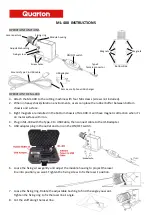
Models 2510 and 2510-AT User’s Manual
PID Control Concepts
4-11
quickly but with larger overshoot. Values too large may cause the system to
become unstable (and most likely oscillate).
•
Kd
(Derivative gain constant)
— This constant helps control the slew rate /
dynamics of the output response waveform. Small values allow the temperature to
move as quickly as possible, while large values control how rapidly the system
responds. Values that are too large may cause the system to become unstable.
Using autotune commands
Autotune command summary
summarizes Model 2510-AT autotune commands. Note that all of these com-
mands are part of the :SOURce[1]:TEMPerature subsystem, which is fully described in
the Section 10 of the Model 2510 User’s Manual.
Table 4-3
Autotune commands
Command
Description
:SOURce[1]
Path to SOURce[1] commands.
:TEMPerature
Temperature commands.
:ATUNe
Auto Tune commands.
:LCONstants
Temperature PID loop constants.
:MSETtle
Use minimum settling time criteria.
:GAIN?
Query temperature gain constant.
:DERivative?
Query temperature derivative constant.
:INTegral?
Query temperature integral constant.
:TRANsfer
Accept and install MSET constants as defaults.
:MOVershoot
Use minimum overshoot criteria.
:GAIN?
Query temperature gain constant.
:DERivative?
Query temperature derivative constant.
:INTegral?
Query temperature integral constant.
:TRANsfer
Accept and install MOV constants as defaults.
:TAU?
Query tau value.
:LAG?
Query lag value.
:STARt <n>
*Set start temperature value.
:STARt?
Query start temperature value.
:STOP <n>
*Set stop temperature value.
Summary of Contents for TEC SourceMeter 2510
Page 194: ...A Specifications...
Page 197: ...B StatusandErrorMessages...
Page 206: ...C IEEE 488BusOverview...
Page 221: ...D IEEE 488andSCPI ConformanceInformation...
Page 225: ...E ExamplePrograms...
Page 233: ...F GPIB488 1Protocol...
















































